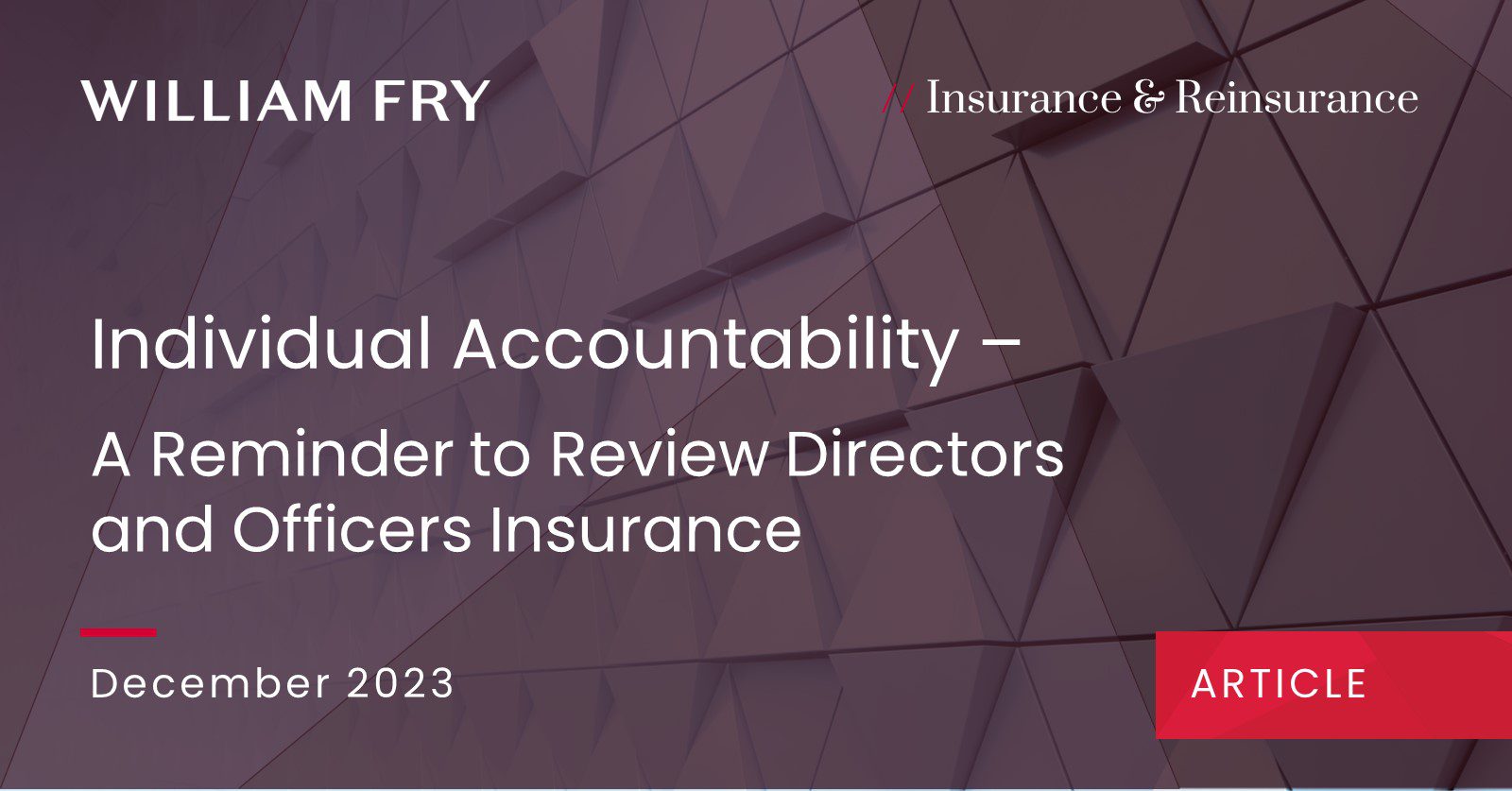As a result of the new Individual Accountability Framework (IAF), persons in key functions within regulated firms will face greater personal exposure. In this article, we examine how corporate indemnities and D&O insurance may assist in mitigating these new personal risks.
The IAF, including within it the Senior Executive Accountability Regime (SEAR) for relevant regulated financial firms, takes effect on a phased basis from 29 December 2023. The regime bolsters the Central Bank’s fitness and probity regime, affecting PCF (pre-approval controlled function) and CF (controlled function) holders. For firms within the scope of SEAR, responsibility mapping and related elements mean directors and other PCF holders must be identified individually as ‘owners’ of aspects of a firm’s business. More generally across all regulated financial firms, there are new conduct standards and additional conduct standards. The full cohort of C-suite and, potentially, a broad range of other individuals (PCFs and CFs) at various operational levels must adhere to the applicable standards.
Personal Exposure
The IAF and SEAR are designed to enable greater personal exposure for persons in key functions. This is added to by the breaking of the so-called “participation link”. Relative to the new requirements, enforcement action may be sought by the Central Bank directly against individuals without the regulator necessarily having first pursued a regulated firm itself for breach. Distinct from other sanctions, such as restriction or prohibition of a person in taking on future financial services roles, the monetary sanction against an individual can be up to €1 million.
The developments heighten distinctions between the position of directors and officers, on the one hand, and that of the regulated firm itself. The IAF and SEAR lead to some greater personal focus on how directors and other officers within affected firms, distinct from the company itself, can fully defend themselves were an alleged breach to arise. In this article, we examine how company indemnities and directors’ and officers’ insurance (D&O Insurance) can assist PCF and CF function holders in mitigating personal risks.
While the article uses the term ‘officer’ (persons beyond directors) a reader, depending on the business, may need to construe it widely. Persons across broad functions in a firm may occupy CF roles of one kind or another. All are potentially affected by the IAF’s conduct standards. Cover under appropriate insurance may need to be available now for what is therefore a large cohort of affected individuals (i.e. no longer just a narrow ‘C-Suite’).
Tailoring
The exposures which a director or other PCF or CF officer faces under the IAF and SEAR are complex. Similarly, the structures through which an affected individual gets comfort that there are measures in place capable of performing in an exposure scenario are technical. It means, for example, that directors or other senior role holders (the areas with the highest risk exposure) always need to be suitably informed. This may extend to a need for personal advice. From a company perspective, as well as working with officers to ensure there is appropriate knowledge, the holding of D&O Insurance will usually include the use of a specialist insurance broker. D&O Insurance is a tailored product. It will need to sit “side-by-side” with other measures. That includes, for example, the extent to which a company itself is capable of giving corporate indemnities through which it can hold harmless, to the extent permitted, an officer should an event arise.
Corporate Indemnities
A first ‘layer of defence’ before looking at D&O Insurance is going to be any indemnification or other contractual comfort a company can have in place for its directors and officers. Companies can offer some, though perhaps not total, protection to directors and officers through the giving of an indemnity. This is typically found in the company constitution. It may also be provided within a stand-alone document between a director or other officer and the company (e.g. including within an employment contract). Directors and officers are advised to check what may be in place.
Whereas the receipt of a corporate indemnity from a firm in which a director or officer is engaged is going to be helpful, it is however not without its limitations. There are public policy grounds on how far a company can absolve its directors and officers from wrongdoing and use of company funds, for example, if there is ultimately a finding of guilt. Section 235 of the Companies Act 2014 states that an indemnity in respect of any negligence, default, breach of duty or breach of trust of a director or officer will be void. Having said this, an indemnity can cover the funding of defence elements. This can extend to civil or criminal proceedings and includes regulatory enforcement action (such as might involve the Central Bank). However, again, in the event of a final finding of guilt, indemnity amounts paid to an officer may come to be refundable to the company. There is also the risk that, when called upon to pay, a firm may prove incapable or unwilling to honour obligations.
D&O Insurance
As a company is unlikely to be able to fully insulate directors and officers through indemnification alone, D&O Insurance is used. Directors and officers will know that, with insurance in place, there can be a claim made by an officer directly on the insurer where a loss event arises. It means therefore, beyond ensuring that the firm has paid for the policy to be in place, there is going to be direct comfort should an issue arise.
Directors and officers need to query with firms that an appropriate policy is in place, and it may extend to including the requirement within, for example, a contract of employment. Section 235 of the Companies Act 2014 expressly allows a company to pay for D&O Insurance. In the context of sophisticated businesses, as will be the case across financial services activities, D&O Insurance is usually viewed as essential. Upon proposed appointment, a director or other key officer may often enquire as to the level and nature of cover in place within a company or group.
What is D&O Insurance?
D&O Insurance provides cover to directors and officers when faced with claims arising from the performance of a role, including breaches of directors’ duties or fiduciary duties, negligence, default, misrepresentation, errors and omissions and non-compliance with regulation. Given the public policy dimension and ensuring cover is not being invoked in an inappropriate way, intentional fraudulent and criminal actions will not be covered. However, a broad range of risks can be. The policy is usually paid for by the company or group itself.
Claims against directors and officers can be from various directions including shareholders, investors, and the firm of which a person is a director or officer as well as from third parties such as a regulator like the Central Bank under its Administrative Sanctions Procedure (as amended by the application of the IAF regime).
Typical Cover
D&O Insurance can protect past, current and future directors and officers as well as provide insurance cover for the company (or a group) itself. The cover protects the personal assets of the insured individual and can also protect the assets of the company or companies in a group. It can cover the defence costs of a claim, any award arising out of the claim, settlements and other costs. This can include regulatory investigations and proceedings. As well as direct recourse by a director or officer, a company will be reimbursed under the policy where it indemnifies a director or officer for liabilities. It may also recover itself then to the extent of being directly pursued.
Considering the incoming IAF and SEAR regimes, firms need to review D&O policies to ensure that actions taken by the Central Bank as a regulator are covered and that existing policies are fit for purpose relative to the new requirements. Points for focus may include, for example, cover where the Central Bank alleges a failure of a duty of responsibility for which a PCF holder (director or other officer) has prescribed or inherent responsibility as well as other areas. Cover under the policy may be required where the Central Bank conducts a regulatory investigation against the individual to whom the IAF/SEAR applies, meaning cost is incurred in the taking of legal or other advice. It may extend to initial regulatory interviews or similar. Individuals will also want to have cover for defence and related costs where the person is ultimately named a defendant in administrative sanction proceedings taken by the Central Bank.
D&O Insurance Structure
D&O Insurance is put in place to perform relative to quite complex risks and is itself a relatively complicated insurance product. Appropriate advice needs to be taken by the firm putting the cover in place as well as, in relevant scenarios, by the insured directors and officers themselves (e.g. sufficiency and structure of cover).
Part of the complexity of D&O Insurance is that it will have different features depending on the company or companies for which the cover is extended. It is therefore structured in different ways. The most common approach is where the cover is divided into two and, potentially, three separate components. These are known as Side A, Side B, and Side C. For a typical Irish financial services firm (unlisted), Sides A and B will be usual. The breakdowns are as follows:
- Side A – cover is for directors and officers directly (i.e. an officer makes a direct claim against the insurer, without necessarily involving the firm itself).
- Side B – cover is for the firm itself, i.e. so it can be reimbursed for a director’s or officer’s legal costs and liabilities which it indemnified (i.e. through extending to its officers the corporate indemnities described earlier).
- Side C – cover for more bespoke elements, especially securities law recourse such as where a company is publicly listed and there may be allegations of misrepresentation or misstatement of financial accounts should shareholders suffer a loss leading to claims.
Points to Consider
The Central Bank’s new IAF and SEAR requirements heighten risk exposures and, consequently, the need for D&O Insurance to be in place. Adequate D&O Insurance coverage will be viewed as essential for many types of activity, including financial services firms. The following are some points to remember:
- Levels of cover can be expensive. It means a level of “trade-off” on what may be available and that a firm is willing to fund within reason. This needs discussion and broker input on what is market standard.
- D&O Insurance is subject to quite extensive limitation and exclusion clauses. There is a need for careful review of the policy wordings, e.g. what is included within the definition of “wrongful act” and how it is potentially curtailed. This is at the core of the policy. For financial services firms in scope for IAF and SEAR, cover broad enough for regulatory action must be included. A general ‘corporate’ policy suitable for other types of company activity is likely to be insufficient.
- D&O Insurance is written on a “claims made” basis. Cover is only available for claims made and reported to the insurer during the policy period (i.e. typically, a one-year window) regardless of when the alleged “wrongful act” occurred. After the policy period, the D&O Insurance is usually no longer available for a claim (unless the circumstances giving rise to the claim were notified to insurers during the policy period). Ensuring ongoing cover each year will be important.
- Which officers have cover needs attention. The policy should extend to prior directors and officers given, for example, the extensive Central Bank look-back period on alleged IAF/SEAR breaches. The Central Bank may come to pursue PCF or CF holders potentially many years after they ceased in a role or working with a firm. Individual “run-off” cover may also be sought for exiting directors or officers in given scenarios.
- D&O Insurance typically includes an aggregate maximum level of recoverable under the policy (i.e. a claims cap). A policy may “exhaust” as recourse is sought by individuals, for example, where there are multiple defendants comprising directors or officers in the context of a single enforcement matter. The claims cap limit may also be shared with the company or other companies within a group structure, increasing the risk of rapid depletion of the aggregate amount of funds available. As such, the cap should be reviewed to ensure that the annual aggregate claim limit is adequate to meet any potential IAF/SEAR risks.
- Thought can be given to likely eventualities. One area is the order in which recourse to cover will arise. Circumstances often mean that the executive directors are first to be affected and claim under a policy. If not properly constructed, as concerns the non-executive directors or others, it means by the time of notifying a claim that the policy limit is spent. D&O Insurance can be designed to include a separate excess cover extension for non-executive directors and others.
- Relative to the IAF and SEAR, ‘heat mapping’ the exposures by reference to the constituency of PCFs and CFs and, for example, inherent and prescribed responsibilities they have under SEAR, will assist in determining cover levels and potentially a ring-fenced recoverable for individual recourse. Recognition needs to be given that the new IAF regime is likely to lead to greater direct enforcement. As referenced above, a personal sanction could be in a monetary amount of up to €1 million plus all associated defence and other costs.
Conclusion
The phased roll-out of IAF and SEAR will take place throughout 2024. A ‘bedding-in’ period can be expected before potential enforcement action by the Central Bank takes place against firms. The regulator has indicated its application will be based upon proportionality, predictability and reasonable expectations. Experiences in similar jurisdictions, such as the UK, indicate restraint in the use of similar measures.
We anticipate D&O Insurance written in the Irish market for affected financial services firms will adapt as firms work with brokers on the IAF and SEAR risks identified for each key officer. The existence and the nature of cover in place will be an agenda item for boards as the individual elements of the IAF, including SEAR, each come into place over 2024.
Contributed by Martha Ní Dhochartaigh




